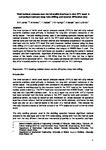Weld residual stresses near the bimetallic interface in clad RPV steel: A comparison between deep-hole drilling and neutron diffraction data
| dc.contributor.author | James, MN | en |
| dc.contributor.author | Newby, M | en |
| dc.contributor.author | Doubell, P | en |
| dc.contributor.author | Hattingh, DG | en |
| dc.contributor.author | Serasli, K | en |
| dc.contributor.author | Smith, DJ | en |
| dc.date.accessioned | 2015-11-19T16:18:05Z | |
| dc.date.accessioned | 2015-11-19T16:20:50Z | |
| dc.date.available | 2015-11-19T16:18:05Z | |
| dc.date.available | 2015-11-19T16:20:50Z | |
| dc.date.issued | 2014-07-15 | en |
| dc.identifier.issn | 0029-5493 | en |
| dc.identifier.uri | http://hdl.handle.net/10026.1/3824 | |
| dc.description.abstract |
The inner surface of ferritic steel reactor pressure vessels (RPV) is clad with strip welded austenitic stainless steel primarily to increase the long-term corrosion resistance of the ferritic vessel. The strip welding process used in the cladding operation induces significant residual stresses in the clad layer and in the RPV steel substrate, arising both from the thermal cycle and from the very different thermal and mechanical properties of the austenitic clad layer and the ferritic RPV steel. This work measures residual stresses using the deep hole drilling (DHD) and neutron diffraction (ND) techniques and compares residual stress data obtained by the two methods in a stainless clad coupon of A533B Class 2 steel. The results give confidence that both techniques are capable of assessing the trends in residual stresses, and their magnitudes. Significant differences are that the ND data shows greater values of the tensile stress peaks (∼100 MPa) than the DHD data but has a higher systematic error associated with it. The stress peaks are sharper with the ND technique and also differ in spatial position by around 1 mm compared with the DHD technique. © 2014 Elsevier B.V. | en |
| dc.format.extent | 56 - 65 | en |
| dc.language.iso | en | en |
| dc.relation.replaces | http://hdl.handle.net/10026.1/3822 | |
| dc.relation.replaces | 10026.1/3822 | |
| dc.title | Weld residual stresses near the bimetallic interface in clad RPV steel: A comparison between deep-hole drilling and neutron diffraction data | en |
| dc.type | Journal Article | |
| plymouth.volume | 274 | en |
| plymouth.publication-status | Published | en |
| plymouth.journal | Nuclear Engineering and Design | en |
| dc.identifier.doi | 10.1016/j.nucengdes.2014.03.042 | en |
| plymouth.organisational-group | /Plymouth | |
| plymouth.organisational-group | /Plymouth/Faculty of Science and Engineering | |
| plymouth.organisational-group | /Plymouth/Faculty of Science and Engineering/School of Engineering, Computing and Mathematics | |
| plymouth.organisational-group | /Plymouth/Users by role | |
| plymouth.organisational-group | /Plymouth/Users by role/Academics | |
| dc.rights.embargoperiod | Not known | en |
| rioxxterms.versionofrecord | 10.1016/j.nucengdes.2014.03.042 | en |
| rioxxterms.licenseref.uri | http://www.rioxx.net/licenses/all-rights-reserved | en |
| rioxxterms.type | Journal Article/Review | en |


